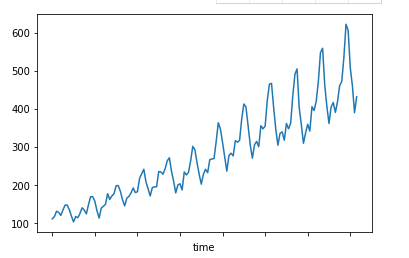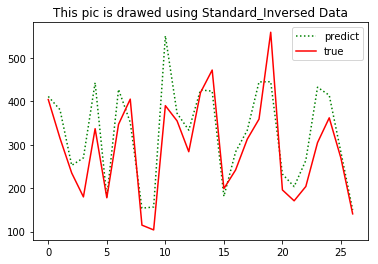LSTM时间序列预测及网络层搭建
一、LSTM预测未来一年某航空公司的客运流量
给你一个数据集,只有一列数据,这是一个关于时间序列的数据,从这个时间序列中预测未来一年某航空公司的客运流量。数据形式:

二、实战
1)数据下载
你可以google passenger.csv文件,即可找到对应的项目数据,如果没有找到,这里提供数据的下载链接:https://pan.baidu.com/s/1a7h5ZknDyT0azW9mv5st7w 提取码:u5h3
2)jupyter notebook
桌面新建airline文件夹,passenger.csv移动进去,按住shift+右键,选择在此处新建命令窗口,输入jupyter notebook,新建名为airline_predict的脚本

3)查看数据:
import pandas as pd
df = pd.read_csv('passenger.csv', header=None)
df.columns = ['time', 'passengers']
df.head(12)
结果如下:我们发现数据以年为单位,记录了每一年中每一月份的乘客量

我们来做出趋势图,看看客运量是如何变化的:
df = df.set_index('time')#将第一列设置为行索引
df.head(12)
import matplotlib.pyplot as plt
df['passengers'].plot()
plt.show()
结果如下:从图上看出,客运量还是逐年增加的


4)处理数据,划分训练集和测试集
import pandas as pd
import numpy as np
from sklearn.preprocessing import MinMaxScaler class Airline_Predict:
def __init__(self, filename, sequence_length=10, split=0.8):
self.filename = filename
self.sequence_length = sequence_length
self.split = split def load_data(self):
df = pd.read_csv(self.filename, sep=',', usecols=[1], header=None) data_all = np.array(df).astype('float')
print(data_all.shape)#(144, 1) #数据归一化
MMS = MinMaxScaler()
data_all = MMS.fit_transform(data_all)
print(data_all.shape) #构造输入lstm的3D数据:(133, 11, 1)
#其中特征是10个,第11个是数值标签 data = []
for i in range( len(data_all) - self.sequence_length - 1 ):
data.append( data_all[ i: i+self.sequence_length+1 ] ) #global reshaped_data
reshaped_data = np.array(data).astype('float64')
print(reshaped_data.shape)#(133, 11, 1) #打乱第一维数据
np.random.shuffle(reshaped_data) #对133组数据处理,每组11个数据,前10个作为特征,第11个是数值标签:(133, 10,1)
x = reshaped_data[:, :-1]
print('samples shape:', x.shape, '\n')#(133, 10, 1)
y = reshaped_data[:, -1]
print('labels shape:', y.shape, '\n')#(133, 1) #构建训练集
split_boundary = int(reshaped_data.shape[0] * self.split)
train_x = x[:split_boundary]
print('train_x shape:', train_x.shape) #构建测试集
test_x = x[ split_boundary: ]
print('test_x shape:', test_x.shape) #训练集标签
train_y = y[ : split_boundary ]
print('train_y shape', train_y.shape) #测试集标签
test_y = y[ split_boundary: ]
print('test_y shape', test_y.shape) return train_x, train_y, test_x, test_y, MMS filename = 'passenger.csv'
AirLine = Airline_Predict(filename)
train_x, train_y, test_x, test_y, MMS = AirLine.load_data()
5)训练模型
#coding=gbk import pandas as pd
import numpy as np
from sklearn.preprocessing import MinMaxScaler import warnings
warnings.filterwarnings('ignore') from keras.models import Sequential
from keras.layers import LSTM, Dense, Activation import matplotlib.pyplot as plt class Airline_Predict:
def __init__(self, filename, sequence_length=10, split=0.8):
self.filename = filename
self.sequence_length = sequence_length
self.split = split def load_data(self):
df = pd.read_csv(self.filename, sep=',', usecols=[1], header=None) data_all = np.array(df).astype('float')
print(data_all.shape)#(144, 1) #数据归一化
MMS = MinMaxScaler()
data_all = MMS.fit_transform(data_all)
print(data_all.shape) #构造输入lstm的3D数据:(133, 11, 1)
#其中特征是10个,第11个是数值标签 data = []
for i in range( len(data_all) - self.sequence_length - 1 ):
data.append( data_all[ i: i+self.sequence_length+1 ] ) #global reshaped_data
reshaped_data = np.array(data).astype('float64')
print(reshaped_data.shape)#(133, 11, 1) #打乱第一维数据
np.random.shuffle(reshaped_data) #对133组数据处理,每组11个数据,前10个作为特征,第11个是数值标签:(133, 10,1)
x = reshaped_data[:, :-1]
print('samples shape:', x.shape, '\n')#(133, 10, 1)
y = reshaped_data[:, -1]
print('labels shape:', y.shape, '\n')#(133, 1) #构建训练集
split_boundary = int(reshaped_data.shape[0] * self.split)
train_x = x[:split_boundary]
print('train_x shape:', train_x.shape) #构建测试集
test_x = x[ split_boundary: ]
print('test_x shape:', test_x.shape) #训练集标签
train_y = y[ : split_boundary ]
print('train_y shape', train_y.shape) #测试集标签
test_y = y[ split_boundary: ]
print('test_y shape', test_y.shape) return train_x, train_y, test_x, test_y, MMS def build_model(self):
#LSTM函数的input_dim参数是输入的train_x的最后一个维度
#train_x的维度为(n_samples, time_sequence_steps, input_dim)
#在keras 的官方文档中,说了LSTM是整个Recurrent层实现的一个具体类,它需要的输入数据维度是:
#形如(samples,timesteps,input_dim)的3D张量
#而这个time_sequence_steps就是我们采用的时间窗口,即把一个时间序列当成一条长链,我们固定一个一定长度的窗口对这个长链进行采用
#这里使用了两个LSTM进行叠加,第二个LSTM的第一个参数指的是输入的维度,这和第一个LSTM的输出维度并不一样,这也是LSTM比较随意的地方
#最后一层采用了线性层 model = Sequential()
model.add( LSTM( input_dim=1, output_dim=50, return_sequences=True ) )
print( "model layers:",model.layers ) model.add( LSTM(100, return_sequences=False) )
model.add( Dense( output_dim=1 ) )
model.add( Activation('linear') ) model.compile( loss='mse', optimizer='rmsprop' )
return model def train_model(self, train_x, train_y, test_x, test_y):
model = self.build_model() try:
model.fit( train_x, train_y, batch_size=512, nb_epoch=100, validation_split=0.1 )
predict = model.predict(test_x)
#print(predict.size)
predict = np.reshape( predict, (predict.size, ) )#变成向量
test_y = np.reshape( test_y, (test_y.size, ) )
except KeyboardInterrupt:
print('predict:',predict)
print('test_y',test_y) print('After predict:\n',predict)
print('The right test_y:\n',test_y) try:
fig1 = plt.figure(1)
plt.plot(predict, 'r')
plt.plot(test_y, 'g-')
plt.title('This pic is drawed using Standard Data')
plt.legend(['predict', 'true']) except Exception as e:
print(e) return predict, test_y filename = 'passenger.csv'
AirLine = Airline_Predict(filename)
train_x, train_y, test_x, test_y, MMS = AirLine.load_data() predict_y, test_y = AirLine.train_model(train_x, train_y, test_x, test_y) #对标注化后的数据还原
predict_y = MMS.inverse_transform( [ [i] for i in predict_y ] )
test_y = MMS.inverse_transform( [ [i] for i in test_y ] ) fig2 = plt.figure(2)
plt.plot(predict_y, 'g:', label='prediction')
plt.plot(test_y, 'r-', label='True')
plt.title('This pic is drawed using Standard_Inversed Data')
plt.legend(['predict', 'true'])
plt.show() print('predict:',np.reshape(predict_y, (predict_y.size,)) )
print('True:',np.reshape(test_y, (test_y.size,)))


三、代码结构

LSTM时间序列预测及网络层搭建的更多相关文章
- (数据科学学习手札40)tensorflow实现LSTM时间序列预测
一.简介 上一篇中我们较为详细地铺垫了关于RNN及其变种LSTM的一些基本知识,也提到了LSTM在时间序列预测上优越的性能,本篇就将对如何利用tensorflow,在实际时间序列预测任务中搭建模型来完 ...
- Kesci: Keras 实现 LSTM——时间序列预测
博主之前参与的一个科研项目是用 LSTM 结合 Attention 机制依据作物生长期内气象环境因素预测作物产量.本篇博客将介绍如何用 keras 深度学习的框架搭建 LSTM 模型对时间序列做预测. ...
- Pytorch循环神经网络LSTM时间序列预测风速
#时间序列预测分析就是利用过去一段时间内某事件时间的特征来预测未来一段时间内该事件的特征.这是一类相对比较复杂的预测建模问题,和回归分析模型的预测不同,时间序列模型是依赖于事件发生的先后顺序的,同样大 ...
- keras-anomaly-detection 代码分析——本质上就是SAE、LSTM时间序列预测
keras-anomaly-detection Anomaly detection implemented in Keras The source codes of the recurrent, co ...
- LSTM时间序列预测学习
一.文件准备工作 下载好的例程序 二.开始运行 1.在程序所在目录中(chapter_15)打开终端 输入下面的指令运行 python train_lstm.py 此时出现了报错提示没有安装mat ...
- Python中利用LSTM模型进行时间序列预测分析
时间序列模型 时间序列预测分析就是利用过去一段时间内某事件时间的特征来预测未来一段时间内该事件的特征.这是一类相对比较复杂的预测建模问题,和回归分析模型的预测不同,时间序列模型是依赖于事件发生的先后顺 ...
- 时间序列深度学习:状态 LSTM 模型预测太阳黑子
目录 时间序列深度学习:状态 LSTM 模型预测太阳黑子 教程概览 商业应用 长短期记忆(LSTM)模型 太阳黑子数据集 构建 LSTM 模型预测太阳黑子 1 若干相关包 2 数据 3 探索性数据分析 ...
- 使用tensorflow的lstm网络进行时间序列预测
https://blog.csdn.net/flying_sfeng/article/details/78852816 版权声明:本文为博主原创文章,未经博主允许不得转载. https://blog. ...
- 基于 Keras 用 LSTM 网络做时间序列预测
目录 基于 Keras 用 LSTM 网络做时间序列预测 问题描述 长短记忆网络 LSTM 网络回归 LSTM 网络回归结合窗口法 基于时间步的 LSTM 网络回归 在批量训练之间保持 LSTM 的记 ...
随机推荐
- Nginx 磁盘IO的优化
L:132
- P1200 你的飞碟在这儿
P1200 题目描述 众所周知,在每一个彗星后都有一只UFO.这些UFO时常来收集地球上的忠诚支持者.不幸的是,他们的飞碟每次出行都只能带上一组支持者. 因此,他们要用一种聪明的方案让这些小组提前知道 ...
- HDU5384-Hotaru's problem-Manacher
找出紧挨的三个回文串,例如abccbaabc ,形如ABA格式,其中AB为回文串.计算最长的长度. 首先用Manacher处理回文半径.然后就是找到两个点,都是偶数的回文串,并且共享了中间一段. 之后 ...
- HDU5769-Substring-多校#4-1006-后缀数组
给定一个字符x和一个字符串.要求输出包含此字符的所有不同字串. 后缀数组可以计算一个字符串的所有不同字串,理解了原理就能做这题了. 对于每一个后缀i,将产生len-sa[i]-hight[i]的前缀, ...
- D. Flood Fill 区间DP 或lcs匹配
题意 给定一串数字 相同的连续的数字可以同时 转换成一个相同数字 问最小几次可以全部转换成一个相同的数字 法1:区间dp dp[l][r][0/1] 0表示l r区间转化成和最左边相同需要多少次 ...
- UOJ273 [清华集训2016] 你的生命已如风中残烛 【数学】
题目分析: 把$0$卡牌看成$-1$.题目要求前缀和始终大于等于$1$. 最后添加一个$-1$,这样除了最后一位之外大于等于1,最后一位等于0. 构造圆排列.这样的话一个圆排列只有一个满足的情况,然后 ...
- 使用 Zabbix 监控 Jenkins
笔者最近的工作涉及到使用 Zabbix 监控 Jenkins.在谷歌上搜索到的文章非常少,能操作的就更少了.所以决定写一篇文章介绍如何使用 Zabbix 监控 Jenkins. 下图为整体架构图: 整 ...
- iptable四表五链
链(内置): PREROUTING:对数据包作路由选择前应用此链中的规则: INPUT:进来的数据包应用此规则链中的策略: FORWARD:转发数据包时应用此规则链中的策略: OUTPUT:外出的数据 ...
- 【BZOJ2940】条纹(博弈论)
[BZOJ2940]条纹(博弈论) 题面 BZOJ 神TM权限题. 题解 我们把题目看成取石子的话,题目就变成了这样: 有一堆\(m\)个石头,每次可以取走\(c,z,n\)个,每次取完之后可以把当前 ...
- CodeForces - 589J(DFS)
题目链接:http://codeforces.com/problemset/problem/589/J 题目大意:一个机器人打扫一个密闭的房间,房间由一个矩形构成,'*'表示家具,'.'表示该位置为空 ...
